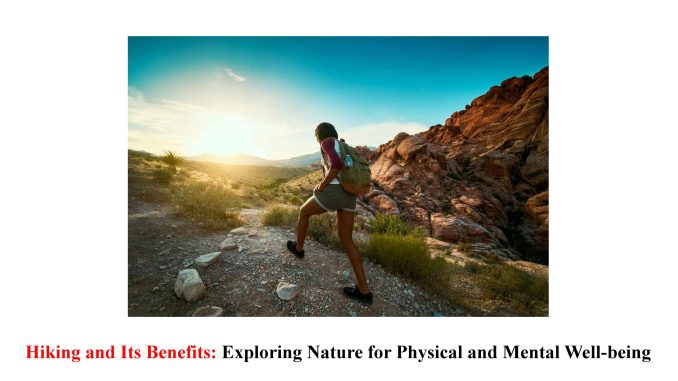
Introduction to Hiking and its Popularity
Welcome to the wonderful world of hiking, where fresh air fills your lungs, breathtaking vistas leave you in awe, and a sense of adventure awaits at every turn! Hiking has soared in popularity over recent years as people seek solace in nature and strive for a healthier lifestyle. And it’s no wonder why! Not only does hiking offer incredible physical benefits, but it also nurtures our mental well-being like nothing else. So grab your boots, pack your backpack, and get ready to explore the many wonders that hiking has to offer! In this blog post, we’ll delve into the various advantages of hitting the trails – from strengthening your body to nourishing your soul. Plus, we’ll provide some practical tips on choosing the right hike for you and ensuring a safe journey along the way. Let’s lace up those boots and embark on an unforgettable adventure through nature’s playground!
Physical Benefits of Hiking
Hiking is not only a great way to explore nature, but it also offers numerous physical benefits. When you hit the trails, your body gets an excellent workout that can improve your overall fitness level.
One major benefit of hiking is its ability to strengthen and tone muscles. As you navigate uneven terrain and climb uphill, your leg muscles work hard to support your body weight. This constant movement helps build endurance and increases muscle strength in your legs, including the quadriceps, hamstrings, calves, and glutes.
Moreover, hiking is a fantastic cardiovascular exercise. It gets your heart pumping and blood flowing throughout your body. Regular hikes can improve cardiovascular health by lowering blood pressure levels and reducing the risk of heart disease.
Another significant advantage of hiking is its impact on weight management. Walking at an incline burns more calories than walking on a flat surface or treadmill. By incorporating hills into your hike, you can burn extra calories while enjoying beautiful scenery.
In addition to these physical benefits, hiking also helps improve balance and coordination as you navigate through different terrains. It engages core muscles as they stabilize you during uneven surfaces or rocky patches along the trail.
Hiking provides an excellent full-body workout that strengthens muscles, improves cardiovascular health, aids in weight management efforts,and enhances balance and coordination skills—making it a perfect activity for those looking to boost their physical well-being while immersing themselves in nature’s beauty!
Mental Benefits of Hiking
Hiking not only provides physical benefits but also has a profound impact on our mental well-being. Spending time in nature has been proven to reduce stress levels and improve overall mood. The soothing sounds of birds chirping, the smell of fresh air, and the beautiful scenery help us disconnect from the hustle and bustle of daily life.
When we hike, we engage all our senses, which can be incredibly therapeutic. The rhythmic movement of walking helps clear our minds and promotes mindfulness. As we immerse ourselves in the natural surroundings, we become more present in the moment, letting go of worries and distractions.
Moreover, hiking allows us to escape technology for a while and connect with ourselves on a deeper level. It gives us an opportunity for self-reflection and introspection. Being surrounded by stunning landscapes can inspire creativity and ignite our imagination.
In addition to these psychological benefits, hiking also boosts our cognitive function. Research shows that spending time outdoors enhances attention span, memory retention, problem-solving skills, and creativity.
Hiking is like therapy for both mind and soul. So next time you’re feeling overwhelmed or stressed out, grab your backpack and hit the trails – your mental health will thank you!
Choosing the Right Trail for Your Fitness Level
When it comes to hiking, one of the most important factors to consider is choosing a trail that matches your fitness level. While it may be tempting to tackle a difficult trail right off the bat, pushing yourself too hard can lead to injuries and take away from the overall enjoyment of your hike.
Start by assessing your current fitness level. Are you someone who exercises regularly or are you just starting out on your fitness journey? This will help you determine whether you should opt for an easy, moderate, or challenging trail.
If you’re a beginner or have limited experience with hiking, start with an easy trail that has minimal elevation gain and well-marked paths. This will allow you to get accustomed to walking on uneven terrain and build up your endurance gradually.
For those who are more experienced or looking for a challenge, moderate and challenging trails offer steeper inclines and rougher terrain. These trails require more physical exertion and can provide a great workout while also allowing you to connect with nature.
It’s also important to consider the length of the trail when choosing one that suits your fitness level. If you’re just starting out, opt for shorter hikes initially and gradually increase the distance as you improve.
Remember, hiking is meant to be enjoyable! Don’t feel pressured into tackling a difficult trail if it doesn’t align with your current abilities. Take time to explore different trails at varying difficulty levels until you find what works best for you.
So lace up those hiking boots, grab some water and snacks, and head out onto a trail that matches your fitness level – adventure awaits!
What to Wear and Bring on a Hike
When it comes to hiking, being prepared is key. Choosing the right clothing and packing essential items can make all the difference in ensuring a comfortable and safe experience. So, what should you wear and bring on a hike?
Let’s talk about clothing. Dressing in layers is always a good idea as it allows you to adjust your body temperature accordingly. Start with moisture-wicking base layers that will keep sweat away from your skin. Opt for lightweight and breathable materials that are quick-drying.
Next, consider wearing sturdy hiking boots or shoes that provide proper support for your feet and ankles. Don’t forget to wear thick socks to prevent blisters.
As for what to bring, water should be at the top of your list. Staying hydrated while hiking is crucial, so carry enough water for the duration of your trip. Additionally, pack some high-energy snacks like trail mix or energy bars to keep you fueled throughout the hike.
Other important items include a map or GPS device, sunscreen, insect repellent, a hat or bandana for sun protection, sunglasses to shield your eyes from harmful rays, and a first aid kit in case of any minor injuries.
Remember to pack light but don’t skimp on essentials! Being well-prepared will allow you to fully enjoy nature’s beauty without worry.
Now that we’ve covered what to wear and bring on a hike let’s move onto some safety tips for a successful adventure in our next section!
Safety Tips for a Successful Hike
When embarking on a hike, it’s important to prioritize safety to ensure an enjoyable and trouble-free experience. Here are some essential safety tips to keep in mind:
1. Plan ahead: Before heading out, research the trail you’ll be hiking, including its difficulty level and any potential hazards. Familiarize yourself with the route and bring a map or GPS device.
2. Check the weather: Keep an eye on the forecast, as unexpected changes in weather can significantly impact your hike. Dress accordingly and make sure you’re prepared for rain or extreme temperatures.
3. Tell someone your plans: Always inform a friend or family member about your hiking plans, including your expected return time. This way, if anything goes wrong, someone will know where to look for you.
4. Pack essentials: Carry sufficient water to stay hydrated throughout your hike and pack nutritious snacks for energy boosts along the way. Don’t forget sunscreen, insect repellent, a first aid kit, extra clothing layers (including rain gear), and a flashlight with spare batteries.
5. Wear appropriate footwear: Invest in sturdy hiking boots that provide ankle support and have good traction on different terrains. Proper footwear reduces the risk of slips, twisted ankles or other injuries.
6. Stay on marked trails: Straying off designated paths can lead to getting lost or encountering dangerous situations such as steep cliffs or unstable terrain.
7. Social distancing during hikes is crucial amidst COVID-19 pandemic; therefore keeping distance from others while maintaining proper hygiene practices like wearing masks should be strictly followed.
8. Wildlife encounters are part of nature’s charm but remember always maintain a safe distance from animals – admire them from afar!
By following these safety tips while hiking, you’ll not only minimize risks but also enhance your overall experience in nature’s embrace!
Sustainable Practices While Hiking
When we venture into the great outdoors, it’s important to remember that we are guests in nature’s home. By practicing sustainable habits while hiking, we can ensure the preservation of our natural surroundings for future generations to enjoy.
First and foremost, always stay on designated trails. Straying off the path not only damages fragile ecosystems but also disrupts wildlife habitats. Stick to marked routes and respect any signage or guidelines provided by park authorities.
Another crucial aspect of sustainable hiking is minimizing your impact on the environment. Pack out what you pack in – this means carrying all your trash with you until you find a proper disposal site. Leaving garbage behind harms both animals and plants, so be responsible and leave no trace.
Additionally, when encountering wildlife during your hike, maintain a safe distance and observe from afar. Feeding or approaching animals can lead to disruption in their natural behavior patterns or even harm them unintentionally.
Water conservation is another key practice while hiking sustainably. Bring refillable water bottles instead of single-use plastic ones and utilize water sources responsibly by using filters or purification methods if necessary.
Consider supporting local conservation efforts through donations or volunteering opportunities. Many organizations work tirelessly to preserve these beautiful landscapes; joining hands with them will contribute directly to their cause.
By embracing sustainable practices while hiking, we demonstrate our commitment to protecting nature’s wonders for ourselves and future generations alike!
Conclusion: Why Everyone Should Give Hiking a Try
Hiking is more than just a walk in the woods; it’s an opportunity to reconnect with nature, rejuvenate your body and mind, and discover new levels of physical and mental well-being. With its numerous benefits for both our bodies and minds, hiking has become increasingly popular among people of all ages.
From a physical standpoint, hiking offers an excellent way to improve cardiovascular fitness, build strength in the lower body muscles, and enhance overall endurance. The uneven terrain challenges your balance and stability while engaging various muscle groups. Whether you’re climbing steep hills or navigating rocky trails, each step taken during a hike contributes to strengthening not only your legs but also your core.
On the mental front, hiking provides an ideal escape from the daily stresses of life. Being surrounded by nature allows you to disconnect from technology and immerse yourself in tranquility. The fresh air clears your mind while the beauty of natural surroundings can uplift your mood and reduce anxiety or feelings of depression. Research has shown that spending time outdoors reduces cortisol levels (the stress hormone) while increasing serotonin production (the happiness hormone), leading to improved mental well-being.
When choosing a trail for hiking, it’s important to consider your fitness level. Beginners should start with shorter distances on easier terrains until they gradually build up their stamina before taking on more challenging hikes. There are plenty of resources available online that provide detailed information about different trails’ difficulty levels so you can choose one that matches your abilities.
Equally significant is wearing appropriate gear for safety purposes during hikes. Comfortable clothing suitable for weather conditions along with sturdy footwear will make your experience more enjoyable while protecting you from potential injuries such as sprained ankles or blisters. It’s also essential to pack essentials like water bottles, snacks high in energy content like granola bars or nuts, sunscreen protection against harmful UV rays,



Leave a Reply